I mentioned in a blog post in May 2020 how I was dismayed at how many wannabe epidemiologists and virologists there are commenting on social media platforms about the severe acute respiratory syndrome coronavirus 2 (SARS-CoV-2) and the coronavirus disease 2019 (COVID-19). We are seeing a resurgence of this at a time when the schools are closed for onsite teaching in South Africa. There is little middle ground on the debate – either opening schools is going to kill grannie and the teachers or the other school of thought is that kids rarely develop COVID-19 and are not super-spreaders. Who to believe? It is all very confusing yet you would think the scientists would debate all these topics with open minds, vigor and integrity. There should be plenty of data out there to guide the scientists towards some type of consensus of what we know and don’t know. Instead I notice esteemed scientists holding to their beliefs and ad hominem responses. The WHO is not helping the cause by changing its views on the non-pharmaceutical public health measures for mitigating the risk and impact of epidemic and pandemic influenza. I downloaded their proposals and policy statements in this regard which was published in 2019. Refer below for an excerpt from this document.
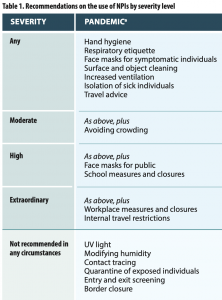 Notice that increased ventilation is recommended and not beach closures. Notice that contact tracing and quarantine of exposed individuals (aka lockdowns) are not recommended in any circumstances. And no border closures please! The WHO’s views on school closures in their 2019 document seems balanced and sensible, I quote:
Notice that increased ventilation is recommended and not beach closures. Notice that contact tracing and quarantine of exposed individuals (aka lockdowns) are not recommended in any circumstances. And no border closures please! The WHO’s views on school closures in their 2019 document seems balanced and sensible, I quote:
“…school measures (eg. stricter exclusion policies for ill children, increased desk spacing, reducing mixing between classes and staggering recesses and lunch breaks) are conditionally recommended, with gradation of interventions based on severity. Coordinated proactive school closures or class dismissals are suggested during severe epidemic or pandemic. In such cases, the adverse effects on the community should be fully considered (eg. family burden and economic considerations), and the timing and duration should be limited to a period that is judged to be optimal…”
Mike Tyson the ex-heavyweight boxing champion famously said “everybody has a plan until they are punched in the face”. The WHO had clearly thought through plans to fight an influenza pandemic, which have plagued Earth for centuries. However, when the first punch landed in China back in early 2020, the WHO may have lacked the cojones to adhere to its stated recommendations.
Let’s have a look at some COVID numbers in South Africa. I have become obsessed with COVID numbers and have built up a significant database of all sorts of interesting stuff. The deaths per capita per province in South Africa is difficult to fathom.
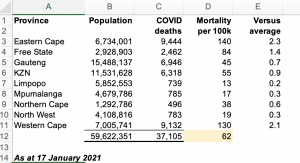
The deaths per capita in the Eastern Cape and the Western Cape are incredibly high relative to Gauteng and KZN. I wonder why? The second wave of deaths is clearly evident in the chart below.
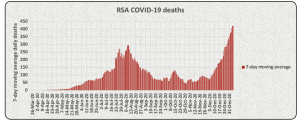
There has been much speculation about the second wave targeting younger people than the first wave. Fortunately, the data does not support that from a mortality per capita perspective.
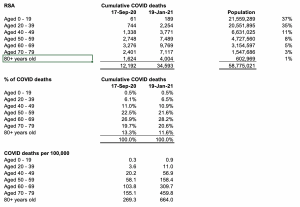 South Africa has a youthful population – ±72% of our population is under the age of 39 with a median age of 27. SARS-Cov-2 is particularly severe for the elderly and South Africa’s data supports this. Notice the much higher deaths per 100,000 for 70+ year olds as compared to the 20 to 39 age bracket? Our age based COVID mortality is not great compared to most European countries but that is another blog post on its own. COVID deaths have dramatically increased in the past 4 months. The percentage of total COVID deaths per age profile is very similar to what it was 4 months ago, not supporting the theory of the second wave hitting younger people harder than previously. Over 60% of all deaths from COVID to date in South Africa were people 60 yers or older.
South Africa has a youthful population – ±72% of our population is under the age of 39 with a median age of 27. SARS-Cov-2 is particularly severe for the elderly and South Africa’s data supports this. Notice the much higher deaths per 100,000 for 70+ year olds as compared to the 20 to 39 age bracket? Our age based COVID mortality is not great compared to most European countries but that is another blog post on its own. COVID deaths have dramatically increased in the past 4 months. The percentage of total COVID deaths per age profile is very similar to what it was 4 months ago, not supporting the theory of the second wave hitting younger people harder than previously. Over 60% of all deaths from COVID to date in South Africa were people 60 yers or older.
The SAMRC has been scaring me for months now with their ‘excess deaths’ data. They reported on 13 January 2021 that excess deaths in South Africa for the period 6 May 2020 to 5 January 2021 was 83,918. That is a staggering amount of higher than expected deaths in country compared to prior years total deaths. StatsSA is a bit sluggish in publishing mortality data. The latest annual publication (Mortality and causes of death PO309.3 report) about deaths was for the 2017 year and that was only published in March 2020. With a declining budget, heaven knows when the next report will be out. StatSA also publishes a mid-year population report which tables births, deaths and estimate population data. This report contradicts the annual mortality report. For example, it reported that annual deaths from all causes, including those Darwin award ones, totaled 517,909 for the year ended June 2017 in its mid-year population report. The annual deaths for the year ended December 2017 was only 446,544 souls. Inconceivable!
Refer below for death data from 2002 to 2017 per StatsSA and the estimated total deaths in 2020 per the SAMRC reports.
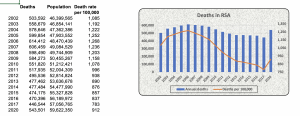
The estimated deaths in 2020 of 912 per 100,00 population is not great compared to the 2017 data but not out of line with 2011 to 2014. The death per capita in 2004 to 2008 was insanely high but that may be due to the ANC’s denial of the HIV epidemic. So until I see more data about deaths in 2018, 2019 and 2020, I am not convinced on ±83,000 excess deaths in 7 months in 2020.
Anyway, I pray the second wave crashes soon and that we can get back to the business of living. Stay safe, follow those sensible WHO guidelines from 2019 and forgive the ANC cadres in government (because they know not what they do). All the best from BeechieB.

Recent Comments